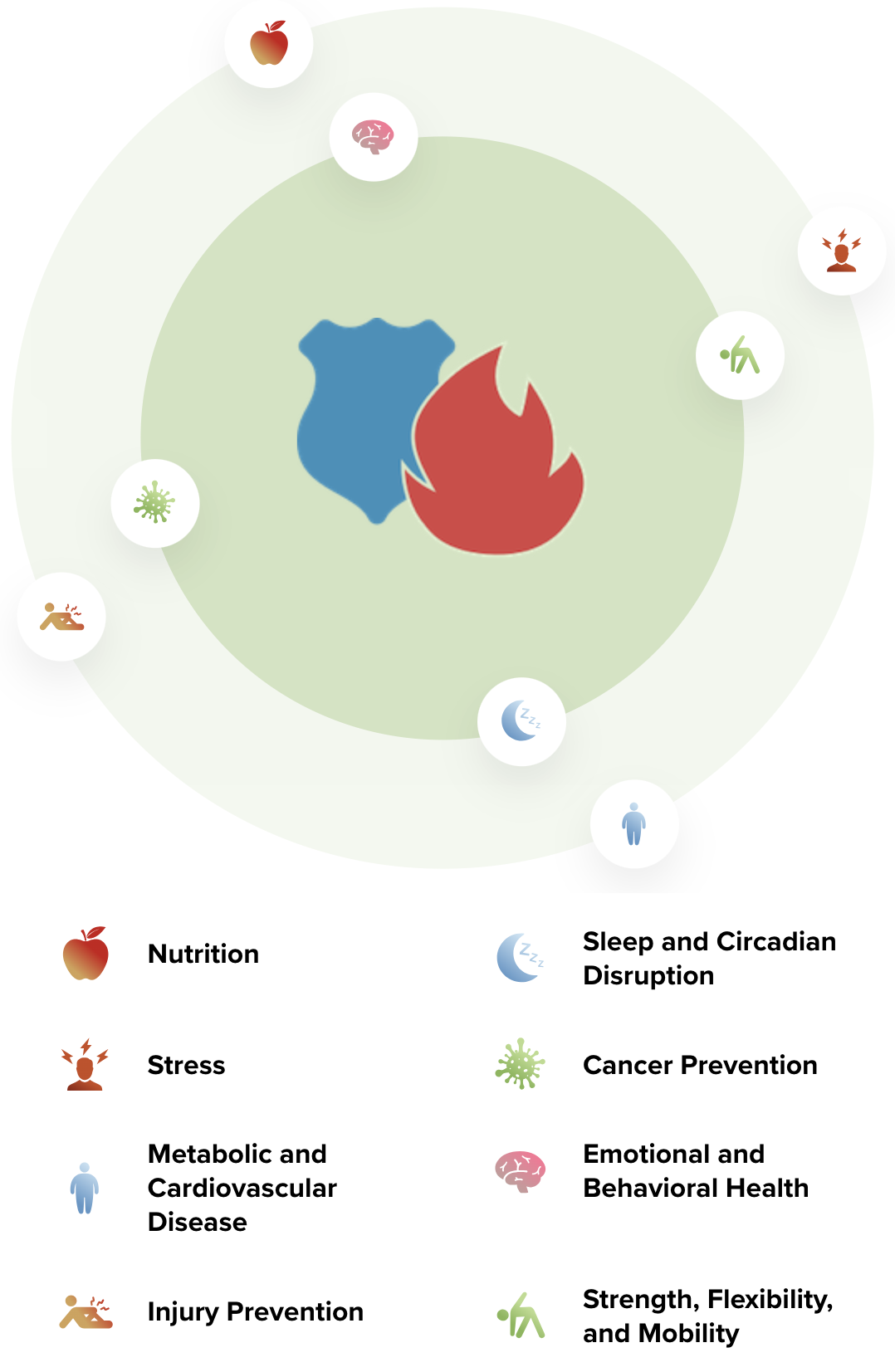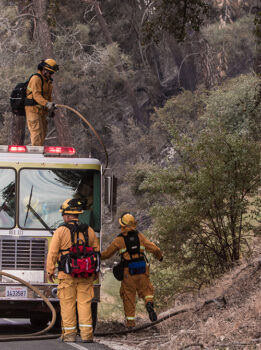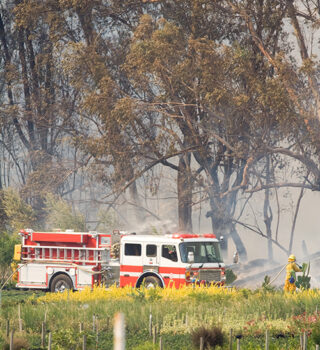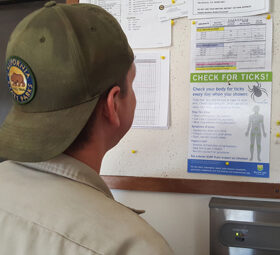BAL Leading the Way Series
 Sunjya Schweig, MD, founder of the California Center for Functional Medicine, discusses a new program he is developing with funding from Bay Area Lyme to provide education and awareness about Lyme disease and the risks of tick-borne infections for firefighters. Firefighters have a profile of unique occupational exposures, including tick bites, and there is a significant lack of education on this topic. This new program aims to create professional, engaging videos featuring firefighters sharing their experiences and providing information on tick bite prevention, checking for ticks, and what to do if bitten. The goal is to roll out the program in California first, targeting professional firefighter and first responder organizations and eventually expanding nationwide. The exact number of firefighters living with Lyme disease is unknown, but it is acknowledged that they have both occupational and recreational exposures. This new program is seen as a way to bring awareness and education to this population and beyond.
Sunjya Schweig, MD, founder of the California Center for Functional Medicine, discusses a new program he is developing with funding from Bay Area Lyme to provide education and awareness about Lyme disease and the risks of tick-borne infections for firefighters. Firefighters have a profile of unique occupational exposures, including tick bites, and there is a significant lack of education on this topic. This new program aims to create professional, engaging videos featuring firefighters sharing their experiences and providing information on tick bite prevention, checking for ticks, and what to do if bitten. The goal is to roll out the program in California first, targeting professional firefighter and first responder organizations and eventually expanding nationwide. The exact number of firefighters living with Lyme disease is unknown, but it is acknowledged that they have both occupational and recreational exposures. This new program is seen as a way to bring awareness and education to this population and beyond.
“Lyme is not really on the radar for many firefighters. They may have had tick bites either in the line of duty or out mountain biking or hiking when they’re off duty, but many don’t know that tick-borne disease is a big problem.”
– Sunjya Schweig, MD
 In 2016, Sunjya Schweig, MD, and the California Center for Functional Medicine were approached to provide wellness programs for firefighters and first responders. There are unique occupational exposures that take a big toll on first responders, and these have been studied and documented. The top two ways that firefighters die are through cancer and suicide, so the wellness program plays an important part in helping firefighters cope with the occupational risks inherent in their work. These are complex problems related not just to the toxins with smoke and the fighting fires, but stress, trauma, and circadian rhythm disruption due to shift work—a variable that the WHO has also classified as a probable carcinogen. Schweig and his team developed a successful six-month-long functional medicine wellness program focusing on nutrition, sleep, exercise, stress reduction, and other proven wellness tools and ran the program with several different firefighter agencies in California and Washington state, but Dr. Schweig realized he was missing a key factor in the program.
In 2016, Sunjya Schweig, MD, and the California Center for Functional Medicine were approached to provide wellness programs for firefighters and first responders. There are unique occupational exposures that take a big toll on first responders, and these have been studied and documented. The top two ways that firefighters die are through cancer and suicide, so the wellness program plays an important part in helping firefighters cope with the occupational risks inherent in their work. These are complex problems related not just to the toxins with smoke and the fighting fires, but stress, trauma, and circadian rhythm disruption due to shift work—a variable that the WHO has also classified as a probable carcinogen. Schweig and his team developed a successful six-month-long functional medicine wellness program focusing on nutrition, sleep, exercise, stress reduction, and other proven wellness tools and ran the program with several different firefighter agencies in California and Washington state, but Dr. Schweig realized he was missing a key factor in the program.
Understanding firefighters’ unique exposure profile
Due to his work in the field of Lyme and tick-borne diseases, Dr. Schweig saw that there was another unique health exposure that firefighters experience: tick bite exposure and the risk of Lyme disease and other tick-borne diseases. He realized that he wanted to create a program to share information regarding the specific occupational risks that firefighters face from exposure to ticks because, as he explains, “Lyme is not really on the radar for many firefighters. They may have had tick bites either in the line of duty or out mountain biking and hiking when they’re off duty, but many don’t know that tick-borne disease is a big problem.”

To understand the specific risk factors for firefighters, we have to think about where these people are physically when they are doing their jobs: a lot of times, they’re working at what Schweig describes as the border of the ‘Urban/suburban interface.’ He adds, “And of course, these risk factors are unique compared to someone who’s working a desk job.” Firefighters as first responders are dealing with the more typical medical calls or accidents in our homes and residential areas, but he notes less obvious potential exposure hot spots: “Firefighters are traipsing around in the brush around the freeway, or running around in hills, canyons, bushes, and woodland … and Lyme is all over California.” In addition, wildland fires present a growing fact of life, with additional significant tick and disease exposure risk.
Tick-borne diseases on the rise nationwide
Ticks have been found in 56 out of 58 counties in our home state, and more infected ticks get recorded every year. Plus, different species of ticks are moving around the country and being found in places previously unrecorded by the CDC and state vector control agencies. In general, ticks and tick-borne diseases are on the rise in locations and altitudes that even surprise tick ecologists. Infected ticks have been recorded at California’s beaches and in our redwood groves. And with California’s wildfire seasons becoming ever more intense, firefighters are in the crosshairs for repeat encounters and are in critical need of basic education on prevention. But what does Dr. Schweig hope firefighters will learn from this program?
“We want our first responders to understand exposure risk, know their options on prevention and repellents, and learn tips on tick checking. Dr Schweig wants to develop a Lyme Disease 101 curriculum that is specific for firefighters, including topics such as:
What to do if you get a bite. How do you remove a tick? What do you do to test the tick? What are the symptoms of acute Lyme versus the symptoms of longer chronic Lyme? Where do you get the right care? What do you do if the doctor tells you there’s no Lyme in California, or do they tell you to flush the tick down the toilet?” These are all typical questions that people ask about ticks, not just firefighters, of course. However, targeting this population is a priority due to their unique risk profile.
“Firefighters are traipsing around in the brush around the freeway, or running around in hills, canyons, bushes, and woodland … and Lyme is all over California.”
– Sunjya Schweig, MD
 Firefighters are near and dear to Dr. Schweig’s heart. “I love working with firefighters, and I also see it as a critical need.” His team initially wants to roll out programming to California firefighters, but they are also hoping to include other first responders and additional agencies like California Highway Patrol, Caltrans, and PG&E. Eventually, Dr. Schweig would like to take the program US-wide. “So many first responders across the country are out there running around after a storm or working at the side of the road or in the forests. In addition, firefighters are doing test fires and controlled burns—plus, when they are off-duty recreating, they may be out hunting, mountain biking, gardening, trail running, etc., possibly tending to be the slightly more outdoor type, which, of course increases their risk of exposure even more.” He adds that reaching these at-risk populations through their work also helps them be more aware of how their leisure time activities expose them to tick-borne diseases, too.
Firefighters are near and dear to Dr. Schweig’s heart. “I love working with firefighters, and I also see it as a critical need.” His team initially wants to roll out programming to California firefighters, but they are also hoping to include other first responders and additional agencies like California Highway Patrol, Caltrans, and PG&E. Eventually, Dr. Schweig would like to take the program US-wide. “So many first responders across the country are out there running around after a storm or working at the side of the road or in the forests. In addition, firefighters are doing test fires and controlled burns—plus, when they are off-duty recreating, they may be out hunting, mountain biking, gardening, trail running, etc., possibly tending to be the slightly more outdoor type, which, of course increases their risk of exposure even more.” He adds that reaching these at-risk populations through their work also helps them be more aware of how their leisure time activities expose them to tick-borne diseases, too.
Delivering key information in short videos over cell phones
CCFM plans to launch the program by capitalizing on the fact that firefighters are very tight communities. He explains that they will leverage this closeness: “They live together, they eat together, they work together, they go out on calls, they come back to the station. It helps if educational information comes from people within those communities. We want to find folk within the fire system, broaden that network, and record them telling their stories with images of nature and ticks interspersed in their interviews. We plan to get signage and other tools into the hands of firefighters.” His program will answer all these questions and more in simple, digestible, small chunks of information that will be easily accessible on firefighters’ phones.
Their idea is to create short videos in the 1-2-minute range in keeping with how people’s attention spans work these days. Dr. Schweig’s team at CCFM has already written and recorded scripts and these are all on their clinic’s Instagram with a curated playlist of tick awareness posts through last spring. In the next phase, they are working to create professional, engaging short videos with narration featuring images and interviews of firefighters. In addition, they have one key differentiator, which adds an exciting twist to this program.
 “We are working to coordinate with wireless network carriers. They have command centers and know who is where because of geolocation. We could potentially use wireless push notifications to tee up key messaging when firefighters are out on a big wildfire, for example, and send out relevant information at the time they need it, in the location they need it, with appropriate links and timely education.” This would be a more contemporary approach. But they would also lean on more traditional collateral like getting signs up in the fire departments to remind people to check for ticks.
“We are working to coordinate with wireless network carriers. They have command centers and know who is where because of geolocation. We could potentially use wireless push notifications to tee up key messaging when firefighters are out on a big wildfire, for example, and send out relevant information at the time they need it, in the location they need it, with appropriate links and timely education.” This would be a more contemporary approach. But they would also lean on more traditional collateral like getting signs up in the fire departments to remind people to check for ticks.
Additional funding is needed to reach over 30,000 personnel
The numbers in California alone are compelling: the California Professional Firefighters Association represents more than 30,000 professional firefighters who get paid to be firefighters, but then there are also a huge number of volunteer firefighters throughout the state who jump in to serve in crises. In addition, the US Forest Service employs wildland firefighters, and Schweig estimates this could be somewhere between 4,000 and 5,000 personnel. In addition to these agencies, there is also Cal Fire, so there’s a mix of many different firefighter organizations that he would like to target. All he needs now is additional funding beyond the initial seed funding provided by BAL.
“We’re hoping to get enough funding to enable us to push forward with our plan. There are two or three main critical time points annually to consider when we want to connect and educate firefighters about Lyme disease: spring, which is when the nymphal ticks emerge looking for a blood meal, and then in July/August as the west coast wildfire season kicks off in earnest, usually wrapping up by Thanksgiving.”
 Ultimately, Dr. Schweig’s program fits perfectly with Bay Area Lyme’s desire to extend education and outreach by leveraging existing affinity groups and professional organizations. Spreading awareness about tick-borne infections and tick bite prevention is more than just information; it is potentially life-saving work for the people who save our lives in a crisis. He concludes, “It’s about reaching people and saying that if you are part of this particular population, this particular group, you have a much higher risk factor for Lyme—and if we’re going to reduce cases and save lives, this is what we have to do.”
Ultimately, Dr. Schweig’s program fits perfectly with Bay Area Lyme’s desire to extend education and outreach by leveraging existing affinity groups and professional organizations. Spreading awareness about tick-borne infections and tick bite prevention is more than just information; it is potentially life-saving work for the people who save our lives in a crisis. He concludes, “It’s about reaching people and saying that if you are part of this particular population, this particular group, you have a much higher risk factor for Lyme—and if we’re going to reduce cases and save lives, this is what we have to do.”
Here at Bay Area Lyme, we couldn’t agree with him more.
Biography: With nearly 30 years of experience in the integrative and functional medicine space, Sunjya K. Schweig, MD, is committed to advancing a data-driven approach to the prevention and reversal of chronic illnesses. He is the founder and president of the California Center for Functional Medicine (CCFM), which provides personalized, precision medicine care. CCFM is known for its comprehensive and data-driven approach to treating complex chronic conditions and has supported first responders with health and wellness programs since 2016.
Dr. Schweig founded the Functional Medicine Research and Technology Center in 2021, focusing on chronic illness research, education, and innovation. He received his B.A. from the University of California, Berkeley, and a full scholarship for medical school at the University of California, Irvine, where he helped build and scale the complementary and alternative medicine curriculum. While completing his family medicine residency at the UCSF Santa Rosa Family Practice Program, he established the residency’s Integrative Medicine Fellowship.
An active medical educator and researcher, Dr. Schweig holds an adjunct faculty position at Touro University College of Osteopathic Medicine and has published articles on botanical medicines for tickborne infections. Board-certified in family practice and integrative and holistic medicine, Dr. Schweig is an advisor for health and tech non-profits, organizations, and startups.
This blog is part of our BAL Leading the Way Series. Bay Area Lyme Foundation provides reliable, fact-based information so that prevention and the importance of early treatment are common knowledge. If you require a copy of this article in a bigger typeface and/or double-spaced layout, please contact us here. For more information about Bay Area Lyme, including our research and prevention programs, go to www.bayarealyme.org.
